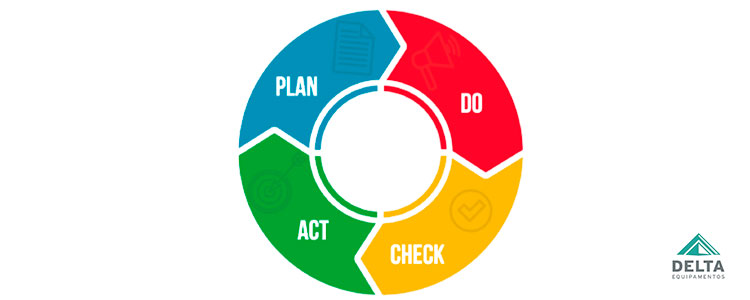The textile market has been evolving significantly, particularly abroad, in regions like Asia. Brazil is increasingly adapting to this new scenario. To stay competitive and not fall behind, companies need to invest in competitiveness, which includes standardizing quality, as it helps optimize processes and achieve better results.
To start standardizing your company’s quality control, you can use proven methodologies that yield a good return.
NeIn this article, we will discuss the main methodologies you can utilize. ste artigo falaremos sobre as principais metodologias que você pode utilizar. Check it out!
PDCA cycle
Generally established in routines and processes, the PDCA cycle, also known as the Deming Cycle or Shewhart Cycle, consists of segmented actions and is made up of four concepts that make up its acronym:
-
Plan:
It is at this stage that the examination of the current method used or the problem that needs to be solved takes place.

This phase is also where the team will define performance indicators to verify if the objective will be achieved. . Although planning is the most complex stage, the more information used, the more accurate the result.
-
Do (do/execute):
After identifying the problems, it’s time to set goals to implement what was previously planned.
When the actions are too complex to implement, it’s possible to develop small PDCA cycles or return to the planning stage to assess the reasons for the failures.
-
Check:
This phase begins as soon as the implementation of the strategies is initiated, as it is important. It’s also possible to identify gaps that can be resolved, as well as opportunities for improvement. If all goals are achieved as expected, the current plan is used as the standard. .
-
Act (act):
Otherwise, it’s necessary to restart the PDCA cycle and further refine the stages. Otherwise, it is necessary to restart the PDCA cycle and improve the steps even further.

The aim of the PDCA Cycle is to help understand how the problem arises and how it can be solved, after observing the causes and not the consequences.
+Learn more: Advanced manufacturing in the Textile Industry. Quality control in the era of Industry 4.0
DMAIC Cycle
Despite also being a tool used for quality management, DMAIC is more intuitive than PDCA and is developed in a quantitative and organized way.
Check out the 5 stages of this methodology in quality standardization:
-
Define
At this stage, the team is formed to work on the project, including people from areas who may have something to contribute.
Problems are selected objectively and the most relevant projects are chosen so that improvements can be found.
KPI analysis and Brainstorming are methods that help a lot at this stage.
-
Measure
This is the phase where performance is evaluated and analyzed quantitatively, so that actions can be applied and the before-and-after can be compared. Data about processes are gathered, as well as the causes of problems.
-
Analyze
Identify the causes of problems and analyze the best ways to solve them, creating opportunities for improvements.
-
Improve
(Improve, em inglês)Test the planned actions and execute the plans according to the process. It’s a phase of implementing changes.
-
Control
Monitor the development, establish criteria to obtain control, analyze the procedures, and update them as necessary.
+Learn more: O que é controle de qualidade?
Como funciona na indústria têxtil?
+Learn more: Textile quality control and mesh preparation
5W2H
5W2H is a tool that can assist in the use of PDCA and aims to answer questions that will help formulate solutions to problems.
Check out the guidelines used for this process now:
- What –What to do (steps);
- Why – Why do it (justification);
- Where – Where to do it (location);
- When – When to do it (time);
- Who – By whom will it be done (responsibility);
- How – How to do it (method);
- How much – How much will it cost to do it (cost).

By answering these questions, you can obtain a detailed action plan that is easy to understand and visualize, as well as defining what actions will be taken, who will do them and how they will execute them. This allows you to better understand the methods, deadlines, responsibilities, resources and objectives.
+Learn more: Advanced manufacturing: what it is and who is already using it
MASP
The Problem Analysis and Solution Methodology is a tool that carries out preventive and corrective actions with the aim of eliminating non-conformities and discovering and resolving the causes of problems so that they do not reoccur..
It uses the PCDA concept, but with a standardized and staggered sequence. For this reason, this type of analysis is carried out in conjunction with other methods and tools to obtain quality.
The MASP stages are:
- Choose the problem and classify it;
- Problem observation;
- Analysis of the phenomenon;
- Preparation of action plans;
- Execution of the plan;
- Verification;
- Standardization.
The use of these methodologies can provide standardization and modernization of quality control and improve internal processes, as fewer errors will occur, productivity can increase and there will be a reduction in costs, as the tendency is for parts to not need be redone or even discarded due to defects.
Want to better understand the benefits of quality standardization? So check out now why standardization in textile production is important!


![E-book]How to ensure quality control in the textile industry?](https://deltamaquinastexteis.com.br/wp-content/uploads/2019/04/ebook-como-garantir-o-controle-de-qualidade-na-industria-textil-1.jpg)